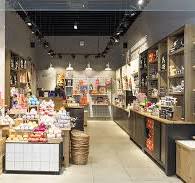Mastering the Art of Shop Design: Creating Captivating Retail Spaces
The Art of Shop Design
Shop design plays a crucial role in shaping the customer experience and influencing purchasing decisions. A well-designed shop not only showcases products effectively but also creates a welcoming atmosphere that encourages customers to explore and engage.
Key Elements of Effective Shop Design:
Layout: The layout of a shop should be intuitive, guiding customers through different sections in a logical flow. Strategic placement of displays and aisles can help create a sense of discovery and encourage browsing.
Lighting: Proper lighting is essential in highlighting products and creating the right ambiance. Natural light, as well as well-placed artificial lighting, can enhance the overall look and feel of the shop.
Colour Scheme: The choice of colours can evoke emotions and set the tone for the shopping experience. Warm tones like reds and oranges can create a sense of energy, while cool tones like blues and greens can promote relaxation.
Visual Merchandising: Displaying products creatively can capture customers’ attention and drive sales. Eye-catching displays, themed arrangements, and storytelling through product placement can all contribute to an engaging shopping environment.
The Impact of Shop Design on Customer Behaviour:
Studies have shown that well-designed shops have a positive impact on customer behaviour. A thoughtfully laid out shop can increase dwell time, encourage impulse purchases, and foster brand loyalty. By creating an immersive shopping experience, retailers can differentiate themselves from competitors and leave a lasting impression on customers.
Innovations in Shop Design:
In today’s digital age, technology is playing an increasingly important role in shop design. Interactive displays, virtual reality experiences, and personalised recommendations based on customer data are just some of the innovations reshaping the retail landscape. By embracing these technologies, retailers can create unique shopping experiences that resonate with modern consumers.
Essential Insights into Shop Design: Addressing 9 Frequently Asked Questions
- What is shop design and why is it important?
- How does shop layout impact customer experience?
- What are the key elements of effective shop design?
- How can lighting enhance the look of a shop?
- What role does colour scheme play in shop design?
- Why is visual merchandising important in a retail setting?
- How does shop design influence customer behaviour?
- What are some innovative trends in modern shop design?
- How can technology be integrated into shop design?
What is shop design and why is it important?
Shop design encompasses the strategic planning and creative execution of a retail space to optimise the shopping experience for customers. It involves considerations such as layout, lighting, colour schemes, and visual merchandising to create an inviting and functional environment. Shop design is crucial because it influences customer behaviour, brand perception, and ultimately, sales. A well-designed shop can attract and retain customers, enhance brand identity, and differentiate a business from its competitors. By paying attention to every detail of shop design, retailers can create a memorable and engaging shopping environment that resonates with their target audience.
How does shop layout impact customer experience?
The layout of a shop plays a significant role in shaping the overall customer experience. A well-thought-out shop layout can influence how customers navigate the space, interact with products, and ultimately make purchasing decisions. An intuitive and visually appealing layout can create a sense of flow and coherence, making it easier for customers to find what they are looking for and encouraging them to explore different sections of the shop. By strategically placing displays, signage, and product categories, retailers can guide customers through a journey that is both engaging and seamless. Additionally, an effective shop layout can help create a welcoming atmosphere that enhances customer satisfaction and encourages repeat visits.
What are the key elements of effective shop design?
When considering the key elements of effective shop design, several factors come into play to create a compelling and engaging retail environment. The layout of a shop is crucial, as it should guide customers seamlessly through different sections while encouraging exploration and discovery. Lighting plays a significant role in highlighting products and setting the desired ambiance, while the choice of colours can evoke specific emotions and influence the overall shopping experience. Visual merchandising is another essential element, as creatively displaying products can capture attention and drive sales by creating visually appealing displays that tell a story and engage customers effectively. By integrating these elements thoughtfully, retailers can create a space that not only showcases their products but also enhances the overall shopping experience for customers.
How can lighting enhance the look of a shop?
Effective lighting plays a pivotal role in enhancing the overall look and feel of a shop. By strategically using lighting elements, retailers can create a welcoming atmosphere, highlight key products, and influence customer behaviour. Properly illuminated displays can draw attention to merchandise, while ambient lighting sets the mood and enhances the shopping experience. Additionally, the right balance of natural and artificial light can accentuate textures, colours, and details, making products more visually appealing to customers. Ultimately, well-executed lighting design not only showcases the shop’s offerings but also contributes to creating a memorable and engaging environment that encourages customers to linger and explore.
What role does colour scheme play in shop design?
The colour scheme in shop design plays a pivotal role in shaping the overall atmosphere and influencing customer behaviour. Colour has the power to evoke emotions, create moods, and convey brand identity. Warm tones like reds and oranges can energise and stimulate, while cool tones like blues and greens can promote a sense of calmness and relaxation. The strategic use of colours can guide customers through different sections of the shop, highlight specific products, and enhance visual appeal. By carefully selecting and harmonising colours in shop design, retailers can create a cohesive and inviting environment that resonates with their target audience and reinforces brand messaging.
Why is visual merchandising important in a retail setting?
Visual merchandising is essential in a retail setting as it serves as a powerful tool to attract customers, create memorable shopping experiences, and drive sales. By strategically arranging products, using eye-catching displays, and telling a cohesive brand story through visuals, retailers can capture the attention of shoppers and influence their purchasing decisions. Effective visual merchandising not only showcases products in their best light but also helps to communicate the brand’s identity and values, ultimately building customer loyalty and enhancing the overall shopping environment. In a competitive retail landscape, visual merchandising plays a crucial role in differentiating a store from its competitors and leaving a lasting impression on customers.
How does shop design influence customer behaviour?
Shop design plays a pivotal role in shaping customer behaviour within retail environments. The layout, lighting, colour scheme, and visual merchandising of a shop all contribute to creating a unique shopping experience that can influence customers’ emotions, perceptions, and actions. A well-designed shop can guide customers through the space in a way that encourages exploration and engagement with products. The use of strategic lighting can highlight key areas or products, while an appealing colour scheme can evoke specific moods or feelings. Effective visual merchandising techniques can capture attention, stimulate interest, and ultimately drive purchasing decisions. By carefully considering these elements in shop design, retailers can create an environment that not only attracts customers but also enhances their overall shopping experience.
What are some innovative trends in modern shop design?
In response to the frequently asked question about innovative trends in modern shop design, several exciting developments are shaping the retail landscape. One prominent trend is the integration of technology to enhance the shopping experience. From interactive displays and augmented reality features to seamless online-offline integration, modern shop designs are leveraging technology to engage customers in new and immersive ways. Another key trend is the focus on sustainability and eco-conscious design practices. Many retailers are incorporating sustainable materials, energy-efficient lighting, and green initiatives into their shop designs to appeal to environmentally conscious consumers. Additionally, personalisation and customization have become increasingly important in modern shop design, with retailers using data analytics and AI-driven technologies to offer tailored experiences that resonate with individual preferences and shopping behaviours. These innovative trends reflect a dynamic shift towards creating unique, customer-centric environments that blend creativity, functionality, and sustainability in today’s retail spaces.
How can technology be integrated into shop design?
Technology can be seamlessly integrated into shop design to enhance the overall customer experience and drive engagement. From interactive displays that allow customers to explore products in a virtual environment to personalised recommendations based on customer data, technology offers endless possibilities for retailers to create innovative and immersive shopping experiences. By leveraging tools such as augmented reality, digital signage, and mobile apps, retailers can not only attract customers but also build brand loyalty and differentiate themselves in a competitive market. Embracing technology in shop design opens up new avenues for creativity and allows retailers to stay ahead of evolving consumer expectations.


